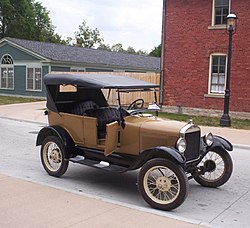Old Cars Wallpaper definition
Source (google.com.pk)During the 1930s the market for used cars first started to grow and decrepit cars were often a poor man's form of transport. Cheap dealers could obtain the cars for very little, make aesthetic adjustments, and sell the car for much more. Early hot rodders also purchased decrepit cars as the basis for racers, and early stock car racing was called banger racing in the United Kingdom and jalopy racing in the United States.
A jalopy was an old-style class of stock car racing in America, often raced on dirt ovals.It was originally a beginner class behind midgets, but vehicles became more expensive with time. Jalopy races began in the 1930s and ended in the 1960s. The race car needed to be from before around 1941. Notable racers include Parnelli Jones.
Numerous slang terms are used to describe such cars, which vary by country and region, including jalopy, clunker, banger, bomb, bunky, beater or rust bucket.
[edit]Australian English
In Australian slang the terms rust bucket, 'bunky', old bomb or bomb are used to refer to old, rusty and/or rundown cars.
[edit]British English
In British slang the terms clunker, old rust bucket or simply bucket are used to refer to decrepit cars but the favoured term is old banger, often shortened to banger. The origin of the word is unknown, but could refer to the older poorly maintained vehicles' tendency to back-fire. The term shed is also used.
[edit]North American English
In American slang jalopy, clunker, old rust bucket and bucket are also used. So too are beater and the more urban hooptie, which gained some popularity from the humorous song My hooptie by Sir Mix-a-Lot. The word jalopy was once common but is now somewhat archaic. Jalopy seems to have replaced flivver (1910), which in the early decades of the twentieth century also simply meant "a failure".[6] Other early terms for a wreck of a car included heap, tin lizzy (1915) and crate (1927), which probably derived from the WWI pilots' slang for an old, slow and unreliable aeroplane.
Of unknown origin, jalopy was noted in 1924.[7] It is possible that the non Spanish-speaking New Orleans-based longshoremen, referring to scrapped autos destined for scrapyards in Jalapa, Mexico, pronounced the destination on the palettes "jalopies" rather than multiples or possessive of Jalapa.[7]
A 1929 definition of jalopy reads as follows: "a cheap make of automobile; an automobile fit only for junking".[8] The definition has stayed the same, but it took a while for the spelling to standardize. Among the variants have been jallopy, jaloppy, jollopy, jaloopy, jalupie, julappi, jalapa and jaloppie. John Steinbeck spelled it gillopy in In Dubious Battle (1936).[9] The term was used extensively in the book On the Road by Jack Kerouac, first published in 1957, although written from 1947.
The term was also used throughout the history of Archie Comics, specifically referring to Archie Andrews' red, open-top antique car.
In 2009 the term "clunker" was heavily used in reference to the Car Allowance Rebate System in the United States, which was also known as the "Cash for Clunkers Program".
Decrepit cars used on Indian reservations in the United States and Indian reserves in Canada are often referred to as reservation cars or rez runners for short.[10] The culture of the rez car was explored in the documentary film Reel Injun,[11] and also figured briefly in the feature film Smoke Signals.
[edit]South Africa
In Afrikaans it is known as "skedonk" and in township slang "skoro" or "skorokoro"
Old Cars Wallpaper Free Wallpaper Pics Pictures Hd for Desktop Iphone Mobile HD 1080p
Old Cars Wallpaper Free Wallpaper Pics Pictures Hd for Desktop Iphone Mobile HD 1080p








0 comments:
Post a Comment